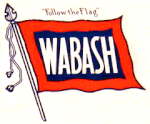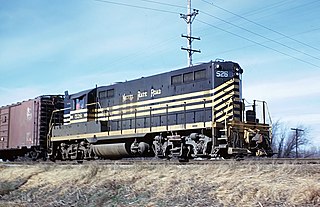
The New York, Chicago and St. Louis Railroad, abbreviated NYC&St.L, was a railroad that operated in the mid-central United States. Commonly referred to as the "Nickel Plate Road", the railroad served parts of the states of New York, Pennsylvania, Ohio, Indiana, Illinois, and Missouri. Its primary connections occurred in Buffalo, Chicago, Cincinnati, Cleveland, Indianapolis, St. Louis, and Toledo.

The Grand Trunk Western Railroad Company was an American subsidiary of the Grand Trunk Railway, later of the Canadian National Railway operating in Michigan, Illinois, Indiana, and Ohio. Since a corporate restructuring in 1971, the railroad has been under CN's subsidiary holding company, the Grand Trunk Corporation. Grand Trunk Western's routes are part of CN's Michigan Division. Its primary mainline between Chicago and Port Huron, Michigan serves as a connection between railroad interchanges in Chicago and rail lines in eastern Canada and the Northeastern United States. The railroad's extensive trackage in Detroit and across southern Michigan has made it an essential link for the automotive industry as a hauler of parts and automobiles from manufacturing plants.
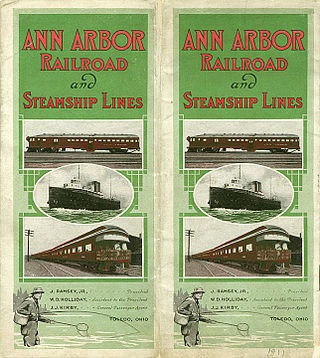
The Ann Arbor Railroad was an American railroad that operated between Toledo, Ohio, and Elberta and Frankfort, Michigan with train ferry operations across Lake Michigan. In 1967 it reported 572 million net ton-miles of revenue freight, including 107 million in "lake transfer service"; that total does not include the 39-mile subsidiary Manistique and Lake Superior Railroad.

Michigan Services are three Amtrak passenger rail routes connecting Chicago, Illinois with the Michigan cities of Grand Rapids, Port Huron, and Pontiac, and stations en route. The group falls under the Amtrak Midwest brand and is a component of the Midwest Regional Rail Initiative.

The Pittsburgh, Cincinnati, Chicago and St. Louis Railroad, commonly called the Pan Handle Route, was a railroad that was part of the Pennsylvania Railroad system. Its common name came from its main line, which began at Pittsburgh, Pennsylvania, crossed the Northern Panhandle of West Virginia, and continued west to Bradford, Ohio, where it split into a northern line to Chicago and a southern one through Indianapolis, Indiana, to East St. Louis, Illinois.
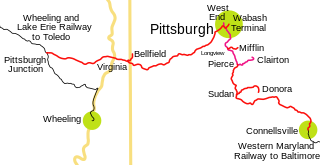
The Pittsburgh and West Virginia Railway was a railroad in the Pittsburgh, Pennsylvania, and Wheeling, West Virginia, areas. Originally built as the Wabash Pittsburgh Terminal Railway, a Pittsburgh extension of George J. Gould's Wabash Railroad, the venture entered receivership in 1908 and the line was cut loose. An extension completed in 1931 connected it to the Western Maryland Railway at Connellsville, Pennsylvania, forming part of the Alphabet Route, a coalition of independent lines between the Northeastern United States and the Midwest. It was leased by the Norfolk and Western Railway in 1964 in conjunction with the N&W acquiring several other sections of the former Alphabet Route, but was leased to the new spinoff Wheeling and Lake Erie Railway in 1990, just months before the N&W was merged into the Norfolk Southern Railway.
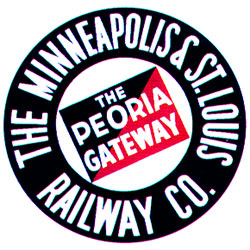
The Minneapolis and St. Louis Railway (M&StL) was an American Class I railroad that built and operated lines radiating south and west from Minneapolis, Minnesota for 90 years from 1870 to 1960. The railway never reached St. Louis but its North Star Limited passenger train ran to that city via the Wabash Railroad.

The Toledo, Peoria and Western Railway is a short line railroad that operates 247 miles (398 km) of track from Mapleton, Illinois, through Peoria across Illinois to Logansport, Indiana. TP&W has trackage rights between Galesburg, Illinois, and Peoria, between Logansport and Kokomo, Indiana, and between Reynolds, Indiana, and Lafayette, Indiana. TPW has connections with UP, BNSF, NS, CSXT, CN, CP, BL, CERA, CIM, KBSR and T&P. The railroad is now owned by Genesee & Wyoming Inc. The railroad's traffic comes largely from agricultural products, including both raw and processed grain products, as well as chemicals and completed tractors. The TPW hauled around 26,000 carloads in 2008.

The Butler Branch was a historic railroad line that operated in Indiana, USA. It ran between the city of Logansport on the Wabash River in north central Indiana and the namesake town of Butler near the Ohio border in northeastern Indiana.
The Kankakee Belt Route is the nickname for the Illinois Division of the New York Central Railroad, which extended from South Bend, Indiana, through Kankakee, Illinois, and westward to Zearing, Illinois. This line was sometimes referred to as the "3 I Line", in reference to a corporate predecessor, the "Indiana, Illinois & Iowa Railroad". That portion of the line west of Kankakee to Moronts, Illinois, roughly parallels the Illinois River in Northern Illinois and was used, in large part, to transport corn toward eastern markets. See Kankakee Outwash Plain
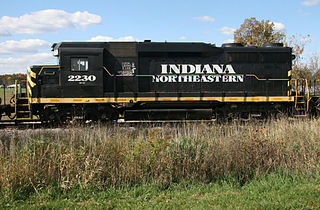
The Indiana Northeastern Railroad is a Class III short line freight railroad operating on nearly 130 miles (210 km) in southern lower Michigan, northeast Indiana and northwest Ohio. The Indiana Northeastern Railroad Company began operations in December 1992 and is an independent privately owned company. As of 2017 the railroad hauled more than 7,000 carloads per year. Commodities moved by the railroad include corn, soybeans, wheat and flour. It also handles plastics, fiberboard, aluminum, copper, coal, perlite, stone, lumber, glass, rendering products, as well as agricultural fertilizers and chemicals.
The Chillicothe–Brunswick Rail Maintenance Authority was a class III railroad that operated in north-central Missouri.
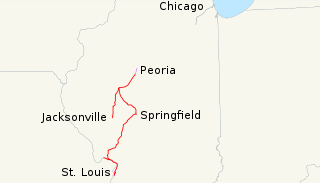
The Chicago, Peoria and St. Louis Railroad (CP&StL) was a railroad in the U.S. state of Illinois that operated a main line between Pekin and Madison via Springfield. Its property was sold at foreclosure to several new companies in the 1920s; the portion north of Springfield has since become the Illinois and Midland Railroad, while the remainder has been abandoned, except for a portion near St. Louis that is now owned by the Norfolk Southern Railway.
The following is a brief history of the North American rail system, mainly through major changes to Class I railroads, the largest class by operating revenue.
The following is a brief history of the North American rail system, mainly through major changes to Class I railroads, the largest class by operating revenue.

The Vandalia Railroad Company was incorporated January 1, 1905, by a merger of several lines in Indiana and Illinois that formed a 471-mile railroad consisting of lines mostly west of Indianapolis.
The Southland was a night train between Chicago, Illinois and different points in western and eastern Florida from 1915 to 1957. In the early years it was called the New Southland. It was distinctive among Midwest to Florida trains as its western branch was the only all-season mid-20th-century long-distance train passing from Georgia to Florida bypassing the usual passenger train hub of Jacksonville Union Station. The main operator was the Louisville and Nashville Railroad, and pooling partners were the Pennsylvania Railroad, the Atlantic Coast Line Railroad and to lesser extent, the Wabash Railroad and the Florida East Coast Railway. For southeast bound -but not northwest bound- trips to Norfolk, Virginia, some coaches in 1946 diverged at Cincinnati along a Norfolk and Western Railway route. Northwest bound, travelers could switch trains at Cincinnati for heading towards Chicago.

The North Missouri Railroad was a railway company that operated in the states of Missouri and Iowa in the mid-19th century. Incorporated in 1851, at its peak it owned or leased nearly 500 miles (800 km) of track. It was reorganized as the St. Louis, Kansas City and Northern Railway, a forerunner of the Wabash Railroad, in 1872.
